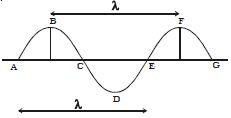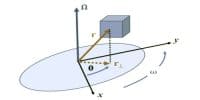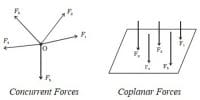Transverse wave motion is that wave motion in which particles of the medium execute Simple Harmonic Motion about their mean positions in a direction perpendicular to the direction of propagation of the wave. Such waves are called transverse waves.
Examples of transverse waves are waves produced by plucked strings of veena, sitar or violin and electromagnetic waves. Transverse waves travel in the form of crests and troughs. The maximum displacement of the particle in the positive direction, above its mean position, is called crest and maximum displacement of the particle in the negative direction, below its mean position, is called trough.
Thus if ABCDEFG is a transverse wave, the points B and F are crests while D is the trough (Figure).

For the propagation of transverse waves, the medium must possess the force of cohesion and volume elasticity. Since gases and liquids do not have rigidity (cohesion), transverse waves cannot be produced in gases and liquids. Transverse waves can be produced in solids and surfaces of liquids only.













